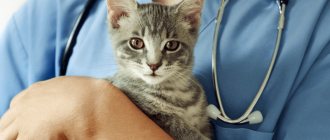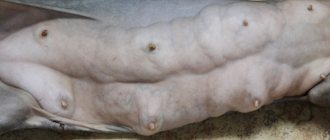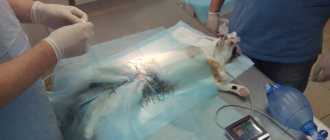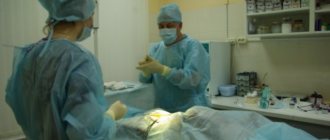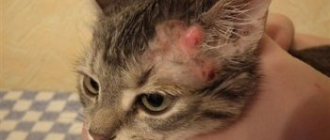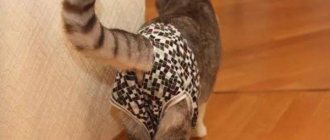A fairly common pathology in domestic cats, characterized by one or both testes not descending into the scrotum, is called cryptorchidism. A cryptorchid cat is not considered sick to the fullest extent of the word, but the phenomenon negatively affects the animal’s ability to produce offspring, and can also cause other ailments.
Today we will talk about how to identify cryptorchidism in a cat, whether castration of cryptorchid cats is mandatory, how the pathology is operated on, and we will discuss post-operative care for the animal.
Cryptorchid cat: surgery
Cryptorchidism in cats: general information
Most often, unilateral cryptorchidism occurs in cats - when one testicle is not descended into the scrotum. Among all animals suffering from this pathology, only two percent have bilateral cryptorchidism, that is, undescended two testes at once. Accordingly, bilateral cryptorzyme is an extremely rare phenomenon. Undescended testicles remain in the peritoneal cavity or “get stuck” in the inguinal canal.
Table 1. Variations in the occurrence of pathology - cryptorchidism
| Name | Description |
| Abdominal | The testis is located in the peritoneal cavity, inaccessible to palpation, and can only be detected through ultrasound examination. In this case, the testis in abdominal cryptorchidism is often underdeveloped, small in size, and may be hidden by intestinal loops or other organs. |
| Inguinal | An undescended testicle is located in the groin area, behind the fat layer, it is quite easy to feel, and in large adult cats with short hair, such an undescended testicle is visible to the naked eye - it looks like an oval tubercle above the scrotum. Cat owners are often frightened, mistaking this variant of cryptorchidism for a neoplasm. |
| False or pseudocryptorchidism | This variant of cryptorchidism, in fact, is not a pathology and has a second name - “wandering testis”. It is characterized by the retraction of a normally developed animal when the animal is afraid or the surrounding temperature is excessively low. |
| Secondary | A complication of false cryptorchidism, when initially both testes are developed normally and descended into the scrotum, but once the testicle is pulled inside, it no longer comes back - due to adhesions inside the peritoneal tissue or the fat layer in the groin area. |
False or wandering cryptorchidism
Causes of cryptorchidism in cats
This deviation does not have an exact and single cause, since the pathology usually has several provoking factors. First of all, these include deviations of a genetic nature, as well as features inherited from a mother or male cat: an excessively narrow inguinal canal, a predisposition to adhesions, a short testicular cord.
Also, a kitten can “get sick” with cryptorchidism due to an infection suffered by the pregnant mother or the kitten itself at an early age, as well as due to postnatal trauma. Pathology can also be caused by hormonal imbalances, as well as forced use of potent drugs by a pregnant cat or newborn kitten.
Unilateral cryptorchidism
Most cases of cryptorchidism in cats are associated with a lack of hormones. They are responsible for contracting a special ligament that pulls the testes from the peritoneal cavity into the scrotum. If there are not enough hormones, the movement of the testicles either does not begin at all or stops midway.
Another common cause of pathology is problems with the nervous and muscular apparatus of the groin area in general or the scrotum in particular. Such problems are considered to be a narrowed inguinal canal, folds blocking the “entrance” to the scrotum or an underdeveloped spermatic cord.
Undescended both testes
Strange as it may seem, the factor that provokes cryptorchidism in cats can be the negligence of the animal owner. Wanting to get offspring from a cat, the owner breeds it without passing the simplest tests on the pet, or without requiring such actions from the cat’s owner. As a result, the animals can infect each other with chlamydia, a virus or infection that will then affect the development of the kittens.
And finally, one of the rare provoking factors is overdeveloped and large testes that physically cannot enter the scrotum area; even the groin canals are of normal size.
Testicles that are too large may simply not fit into the scrotum
Caring for a cat after castration
After castration, the animal needs rest. To prevent the surgical suture from licking, it is recommended to wear a protective blanket or collar. After the operation, the surgeon will prescribe antiseptic solutions and ointments for treating the sutures. It is necessary to ensure that the seams are always dry and clean. If redness and soreness of the tissues around the suture, or discharge of pus or blood from the suture appears, immediately show the cat to a veterinarian!
Sutures are removed 10-14 days after surgery. The only measure to prevent cryptorchidism in cats is to exclude cryptorchid cats from breeding.
Cryptorchidism: clinical picture of pathology
The main symptom is, of course, a visual or manual defect. Cryptorchidism can be noticeable with the naked eye, as well as upon palpation. However, not every animal will allow you to palpate the intimate area, and not every owner is interested in probing the cat’s scrotum. In this case, nonspecific, non-characteristic signs become:
- Lack of pregnancy in a cat, despite multiple matings (the symptom may not appear in half of the cryptorchid cats - they continue to be able to “make” offspring).
- Cryptorchid cats, unlike full-fledged cats, are more likely to try to harass cats, even when they are not in heat. In turn, during a period favorable for mating, cats are more aggressive towards cryptorchids than towards cats with normal development.
- The scrotum does not look tight and full, but rather flabby and wrinkled.
- When urinating, the animal may shudder; cryptorchid cats often go “small” to the toilet, like dogs - with one hind paw raised.
Cryptorchid cats have peculiarities when urinating
- Concomitant diseases of the genitourinary system. Sometimes undescended testes are accompanied by testicular neoplasms.
- Loss of fur. Due to a lack of appropriate hormones, cryptorchid cats may begin to go bald. Darkening of the skin in the genital area is also observed - for the same reason.
- Tendency to lose masculinity. Cryptorchids, as they grow older, lose their brutal “masculine” features and become more refined, the skeleton becomes thinner, and the appearance of the cat becomes similar to the appearance of a graceful cat.
Cryptorchidism makes a cat look like a cat
But a rare symptom in cryptorchids is pain. Pathology produces painful symptoms only when the testes remaining in the peritoneal cavity already experience negative changes, for example, they become inflamed or develop into a neoplasm.
In severe cryptorchidism, the cat exhibits a painful reaction when the owner or veterinarian palpates the peritoneum. This is due to the twisting of the testicle on the axis, which entails pinching of the nerve canals, vessels and ducts that remove the seed. This process causes severe inflammation; in extreme cases, necrotic phenomena and even organ decomposition are possible.
The cat’s increased attention to the scrotum area is a reason to check the “set” of testes
How to detect cryptorchidism in kittens and cats?
When purchasing a small kitten, the future owner is unlikely to be able to detect cryptorchidism in it. Firstly, the testes are still too small, and secondly, normally they can enter the scrotum for up to three to five months. If your pet has reached the age of six months, and one or two testicles are still not palpable, you need to visit a veterinarian.
Surgery is mandatory for a cryptorchid cat
Important point! Unscrupulous breeders can hide from the owner the fact that the kitten has a pathology. At the same time, if cryptorchidism is discovered in a cat, not only the owners who purchased a purebred animal with the initial prospect of breeding will suffer, but also the owners of the outbred cat, since both will need surgery.
If the testis, which has not descended into the scrotum, is not accessible for palpation, an ultrasound examination should be performed in order to draw up a surgical plan.
How to prepare a cat for an ultrasound?
Diagnosis and treatment
Unfortunately, it is not possible to determine the presence of latent cryptorchidism in newborn male kittens. The only precaution may be to test the potential father of the kitten. If the cat that inseminated the cat is cryptorchid, the likelihood of developing pathology in the offspring increases significantly.
The descent of the testes into the scrotum in cats occurs upon reaching the age of six months. The owner must monitor the deadlines. If one or both testes of the kitten have not descended visually or by palpation at this age, you should seek help from a veterinarian. Depending on the type of cryptorchidism, the diagnosis varies. Thus, the inguinal type of anomaly is determined simply by palpation. For the abdominal type of pathology, ultrasound diagnostics is necessary.
Owners of cats diagnosed with a unilateral type of cryptorchidism want their pet to retain its manhood. But veterinary experts strongly recommend surgical intervention for the purpose of complete castration. This is due to several factors. Thus, cats who have had their testicles partially removed have a more aggressive character, so castration allows you to make your pet more docile.
Pedigree cryptorchid cats are always excluded from further breeding due to genetic inheritance. Kittens obtained from a cat with an abnormality of the testes will inherit the pathology in any case. Therefore, there will be no benefit from one testicle, except for the complacency of the owner. Also, pets, even with one remaining testicle, are prone to marking territory and spring rutting (sexual heat).
Castration should be carried out only in a hospital hospital after a thorough diagnostic examination.
Echocardiography is performed, which will exclude the presence of congenital cardiomyopathies in the cat, as well as a general clinical blood test. This is necessary in order to assess the risks of surgical manipulation performed under general anesthesia. The duration of the operation is about 15-60 minutes, depending on the severity of the pathology.
An appendage that has descended into the scrotum is removed as standard, while a hidden appendage is removed, depending on its location. When inguinal cryptorchidism is diagnosed, the area at the location of the testis is shaved, tissue is dissected, the testicle is pulled out, cut off with a scalpel, the spermatic cord is cauterized using an electrocoagulator or a ligature is applied.
The abdominal type of cryptorchidism requires skill from a veterinarian. Tissue dissection is carried out along the linea alba of the abdomen, the testis is pulled out and cut off. Upon completion of the surgical procedure, suturing is performed.
Treatment for a cryptorchid cat
Cryptorchidism itself is not a fatal disease, and in some cases it is not dangerous to the health of the cat. But this does not mean that the owner should ignore the problem. There are two options for treating a cryptorchid cat: with drug therapy and surgery.
Cryptorchidism and hormone therapy
To treat cryptorchidism, in some cases, hormonal drugs are used, which are designed to compensate for the lack of the cat’s own hormones. This treatment option is used only after completing a full course of tests and studies, and with a confirmed lack of the hormone testosterone. That is, in the case when its deficiency is really the root cause of the pathology.
The use of hormone therapy in kittens under one year of age is prohibited, since drugs that include a serious dose of testosterone negatively affect the hypothalamus, which will certainly affect the proper growth of bones and ligaments in the skeleton of a young animal.
Hormone therapy is only permissible for mature adult cats.
Note that drug treatment is often ineffective at all, or has a temporary positive effect. As soon as artificial testosterone is no longer administered to the animal, the pathology reasserts itself.
In addition, hormone therapy requires expensive tests, and the price of the drugs themselves is quite high. Veterinarians argue that there is no particular point in trying to treat a cat in this way - anyway, the animal should not be allowed to be bred so that it does not pass on the inferiority gene to its offspring.
Even cats with cured cryptorchidism are not allowed for breeding
Cryptorchid sterilization
According to veterinary experts, the most effective and radical way to solve a problem such as cryptorchidism is to sterilize the animal. We are talking specifically about sterilization, not castration, since cryptorchids require a full-fledged strip operation.
The intervention of a veterinary surgeon will not only ensure complete suppression of the animal’s desire to continue its breeding, but will also not allow the undescended testis to degenerate into a malignant tumor. It is this “side effect” that is the most terrible for a cryptorchid cat.
The process of sterilization of a cat with cryptorchidism
The ideal age to perform surgery on a cat is seven to eight months, but later surgical intervention is possible, up to eight to nine years. Before performing abdominal surgery, you need to consult with a specialist, take biochemistry and a general blood test with the animal, and also perform an ECG procedure in order to rule out cardiac ailments of the cat that could negatively manifest themselves during the administration of anesthesia or the operation itself.
As we have already mentioned, sterilization of a cat with pathology is a full-fledged operation, during which the surgeon enters the abdominal cavity of the animal. The operation takes place under full anesthesia and lasts approximately one and a half hours. Operative access will depend on which variation cryptorchidism belongs to.
Before surgery on an animal, you need to undergo a short medical examination.
Surgery for inguinal cryptorchidism
The animal, which has passed the tests, is put under anesthesia. The doctor will then use an electric razor to shave the hair around the incision area. The skin and adipose tissue are cut with a scalpel, the undescended testis is removed, and the testicular cord is cauterized with an electrical device - a coagulator. Stitches are then applied.
To protect the operated area from the cat’s rough tongue (during healing, the stitches itch and the cat will try to lick them), you need to put a special plastic collar on the cat. The pet will wear this collar until the suture material is removed - usually this happens within ten days after the operation.
The cat must be wearing a protective collar at all times.
It is also prohibited for a cat to lick a seam because a pet can easily introduce bacteria and dirt into a fresh wound along with saliva. Sutures need to be treated daily; Chlorhexidine is good for this purpose, but the doctor can independently smear the incision site with a long-acting antiseptic.
Surgery for abdominal cryptorchidism
This operation almost completely copies sterilization in cats. The animal is put under anesthesia, the belly is shaved, and then the belly is incised along the “linea alba,” finding the vas deferens. It is located next to the bladder, and the incision will be in this area. One or two testicles remaining in the peritoneum are pulled out and removed, after which suture material is applied.
Cat in anesthesia
Just like after surgery for inguinal cryptorchidism, the cat will need to purchase a protective collar, which he will wear until the stitches are removed.
Video - Operation for a cryptorchid cat
Treatment of cryptorchidism
Castration is the treatment of choice for cryptorchidism. Twisting of the spermatic cord of the testis located in the abdominal cavity may occur. Although this is a very rare occurrence, it can cause severe abdominal pain and other complications. Prompt access to an undescended testis depends on its location. It is easy to find the testis by following the vas deferens. Laparoscopy can be used to remove an undescended testis.
The most common treatment method, other than acupuncture and herbal medicine, is the use of luteotropic hormone-enhancing drugs, such as choriogonadotropin and gonadotropin-releasing hormone, which increase the production of endogenous luteotropic hormone.
Most studies report the effectiveness of hormonal therapy compared with control groups of cryptorchids. Control of cryptorchidism is complicated by the need to exclude cryptorchids themselves and, preferably, their mothers and sisters from breeding.
Rehabilitation after surgery
When taking an animal home after surgery, the owner should be aware of some rules that will allow rehabilitation to be carried out quickly and with minimal discomfort for the cat.
Firstly, you need to prepare in advance the place where the cat will be for the first hours after the operation. The animal is protected from drafts and excessively hot radiators. Fine. If you manage to restrict your pet’s movements using a carrier or cage, the cat will feel insecure when recovering from anesthesia and may get injured.
During the first hours after recovery from anesthesia, the cat should be monitored or placed in a cage.
You need to carefully monitor your pet's condition, reporting any negative changes to your doctor. If the cat refuses to eat for the first day or two, it's not a big deal. If the animal continues to ignore food, behaves lethargically and is not interested in anything, this is a reason to urgently visit a doctor.
Another common side effect of abdominal surgery in cats is the absence of bowel movements. To help your pet, you can give him a teaspoon of Vaseline oil, which acts as a mild laxative. But, it is worth using it on the third or fourth day if the cat was still unable to defecate on its own.
The oil can be mixed with food or administered into the cat's mouth using a rubber bulb.
You must also carefully follow the individual recommendations of your veterinarian. The cat may be prescribed hemostatic drugs, anti-inflammatory or antibiotics, and vitamins.
Methods of therapy
Carrying out the operation
It is best for an animal with this diagnosis to be neutered.
The main treatment for cryptorchidism is surgery, which is performed in several ways. As a rule, complete castration of a cryptorchid cat is carried out. Some believe that it will be better for the pet if at least one testicle remains. But veterinarians recommend complete removal of organs, explaining this with a number of advantages:
- exclusion of breeding and transmission of cryptorchidism to kittens;
- eliminating aggression;
- getting rid of spring torments, and getting rid of yourself from the constant meowing and screams of the cat.
The surgical technique is selected by the veterinarian individually for each pet and depends on the type and severity of the disease. Before surgery, your cat will need to have a blood test and a cardiac exam. Surgery for cryptorchidism is performed under general anesthesia, since the manipulation is painful. The duration of the procedure is from 60 minutes to one and a half hours. The pet is prescribed abdominal surgery, during which the descended testis is completely removed, and the hidden one, given the type of cryptorchidism. If the disease is of the inguinal type, then the cat’s belly hair is first shaved off, after which the veterinarian surgeon makes an incision and excises the testicle, and the spermatic cord is cauterized and tied.
The operation for the abdominal type of cryptorchidism is particularly difficult, since the procedure is reminiscent of sterilizing a cat. A long incision is made, the ovary is pulled out beyond the vas deferens and excised completely.
Care after surgery
If there is a need for pain relief, the animal should be given medications prescribed by a doctor.
An operated cat requires special care for a speedy recovery. During the rehabilitation period, owners should adhere to the following recommendations:
- The apartment should have a stable temperature and no drafts.
- An animal with cryptorchidism is given a special collar to prevent scratching of the stitches.
- Regular treatment of wounds with antiseptic solutions.
- Give your cat medications to reduce fever or pain, if necessary.
- If it is difficult to remove stool, a laxative is given.
- Under no circumstances should they give medications at their own discretion, since even Paracetamol or Drotaverine, which is familiar to the human body, can lead to the death of a pet.
